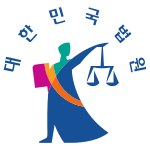
Back Corte Suprema de Corea del Sur Spanish دیوان عالی کره جنوبی Persian Cour suprême de Corée French בית המשפט העליון של קוריאה הדרומית HE Mahkamah Agung Korea Selatan ID 大法院 (大韓民国) Japanese 대한민국 대법원 Korean Sąd Najwyższy (Korea Południowa) Polish Верховный суд Республики Корея Russian Tòa án Tối cao Hàn Quốc Vietnamese
| Supreme Court of Korea | |
|---|---|
| 대한민국 대법원 | |
 Symbol of the Supreme Court of Korea | |
 Supreme Court of Korea in Seocho-gu, Seoul | |
 | |
| Established | 1948 |
| Location | Seocho, Seoul |
| Composition method | Appointed by President with consent of National Assembly (for associate Justices, nomination of Chief Justice is additionally required) |
| Authorised by | Constitution of South Korea Chapter V |
| Judge term length | Six years, renewable (mandatory retirement at the age of 70) |
| Number of positions | 14 (by statute) |
| Website | scourt |
| Chief Justice | |
| Currently | Jo Hee-de |
| Since | 8 December 2023 |
| Supreme Court of Korea | |
 Emblem of ordinary Courts of Korea | |
| Korean name | |
|---|---|
| Hangul | 대법원 |
| Hanja | 大法院 |
| Revised Romanization | Daebeobwon |
| McCune–Reischauer | Taebŏbwon |
| This article is part of a series on |
 |
|---|
The Supreme Court of Korea (Korean: 대법원; Hanja: 大法院; RR: Daebeobwon) is the highest ordinary court in the judicial branch of South Korea, seated in Seocho, Seoul. Established under Chapter 5 of the Constitution of South Korea, the court has ultimate and comprehensive jurisdiction over all cases except those cases falling under the jurisdiction of the Constitutional Court of Korea. It consists of 14 justices, including the chief justice of the Supreme Court of Korea. The Supreme Court is at the top of the hierarchy of all ordinary courts in South Korea, and traditionally represented the conventional judiciary of South Korea. The Supreme Court has equivalent status as one of the two highest courts in South Korea. The other is the Constitutional Court of Korea.